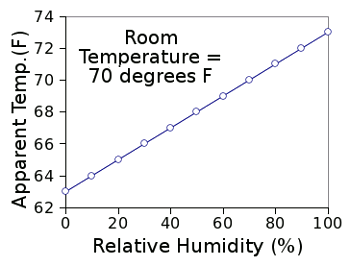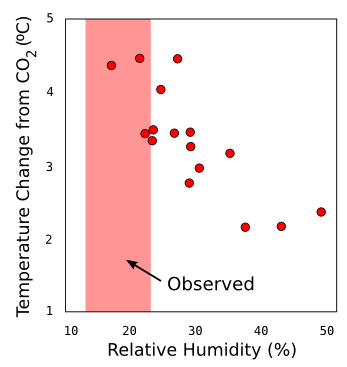Heat and Humidity
November 26, 2012
Most large
laboratory buildings have a resident building
engineer, and ours was an amiable guy who would give us status reports as he walked the hallways from one area to another. One cold
winter's day he told me that people were complaining about the building being too cold, so he increased the
relative humidity, rather than the
temperature (see figure).

There's a saying that "It's not the heat, it's the humidity."
Humidity determines how we perceive temperature.
Graph rendered with Gnumeric)
Humidity plays a large part in how we perceive the temperature of our
environment, and it's now becoming important in how we perceive the accuracy of our
models in predicting
global climate change.
Scientists at the
National Center for Atmospheric Research (NCAR,
Boulder, Colorado) have examined how well climate models reproduce observed
tropical and
subtropical relative humidity.[1-3]
The models that are best at predicting the relative humidity were the ones that predict highest global warming.[1-3] Says NCAR scientist
John Fasullo, a co-author of a report on this research in
Science,
"There is a striking relationship between how well climate models simulate relative humidity in key areas and how much warming they show in response to increasing carbon dioxide... Given how fundamental these processes are to clouds and the overall global climate, our findings indicate that warming is likely to be on the high side of current projections."[3]
One complaint about climate models is that there are quite a few. Although they all agree that the
Earth will warm because of increased levels of
carbon dioxide in the
atmosphere, they don't give the same temperature rise.[1] The differences in these models relate to second-order effects; namely, how much a temperature rise will affect
parameters in the models. One of these,
cloud feedback, is important, since warming will affect
cloud cover.[1]
Climate models are usually compared by their prediction of global warming when the atmospheric carbon dioxide levels are twice the
preindustrial level of about 280
ppm. This benchmark is known as the
equilibrium climate sensitivity.[3] Today's
CO2 level is around 390 ppm, and at current
emission levels, this doubling will be reached before the year 2100.[3] Most models have predicted a temperature rise of about 3
°C (5
°F), but some models predict as high as 8 °C, or as low as 3 °C.[3]
Adding cloud data to models is difficult, since it's difficult to acquire cloud cover data using
satellite imaging.[3] Satellites, however, are better at measuring atmospheric
water vapor, so accurate measurements of relative humidity can be done. As a surrogate to actual cloud data, the recent NCAR study used satellite observations of relative humidity in subtropical regions. The NCAR scientists used data from instruments on two NASA satellites, the
Atmospheric Infrared Sounder (AIRS), and the
Clouds and the Earth's Radiant Energy System (CERES).[3]
The study found that, for the tropics and subtropics, seasonal variations in relative humidity
correlate with increased
albedo caused by clouds.[2] In this case, the seasonal variation in temperature mimics the affects of global warming. The result of the study, as shown in the figure, is that models that don't incorporate such cloud effects give too low an estimate for global warming.[2-3]

Temperature rise for a doubling of atmospheric carbon dioxide from pre-industrial levels, as predicted by sixteen climate models, as a function of their relative humidity predictions. The models that are closest to observed humidity values predict a greater global warming.
(Illustration rendered by the author using Inkscape, from data in ref. 2.)[2-3)]
In the above figure, the
abscissa shows the
May-to-
August relative humidity for the atmosphere between 20,000 to 30,000 feet
altitude for southern subtropical regions between about 10° and 25°
latitude. Observations showed that the the relative humidity averaged between about 15-25%, but most models predicted relative humidities greater than 30%.
The models with relative humidity in the observed range predicted a global temperature rise for a doubling of atmospheric carbon dioxide to be 3.5-4.5 °C.[3] The NCAR research was funded by NASA.[3]
References:
- Karen M. Shell, "Perspective: Climate Change - Constraining Cloud Feedbacks," Science, vol. 338 no. 6108 (November 9, 2012), pp. 755-756.
- John T. Fasullo and Kevin E. Trenberth, "A Less Cloudy Future: The Role of Subtropical Subsidence in Climate Sensitivity," Science, vol. 338 no. 6108 (November 9, 2012), pp. 792-794.
- Future warming likely to be on high side of climate projections, analysis finds, National Center for Atmospheric Research Press Release, November 8, 2012.
Permanent Link to this article
Linked Keywords: Laboratory; engineer; winter; relative humidity; temperature; saying; Gnumeric; environment; computer simulation; computer model; global climate change; scientist; National Center for Atmospheric Research; NCAR; Boulder, Colorado; tropics; subtropics; John Fasullo; Science; Earth; carbon dioxide; atmosphere of Earth; parameter; cloud; feedback; cloud cover; Industrial Revolution; preindustrial; parts-per notation; ppm; equilibrium climate sensitivity; CO2; greenhouse gas; emission; Celsius; °C; Fahrenheit; °F; satellite imaging; water vapor; Atmospheric Infrared Sounder; Clouds and the Earth's Radiant Energy System; correlation and dependence; albedo; Inkscape; abscissa; May; August; altitude; latitude.